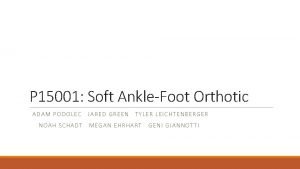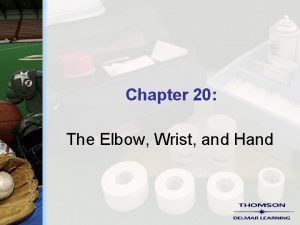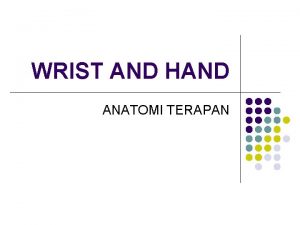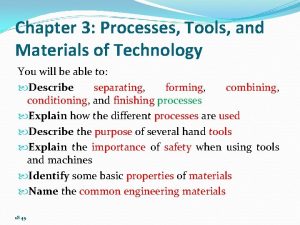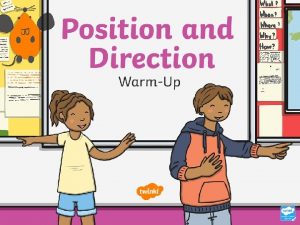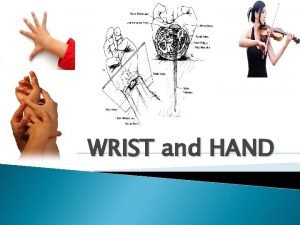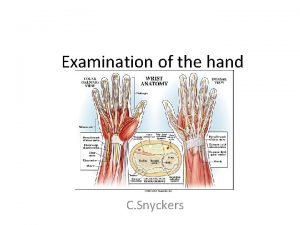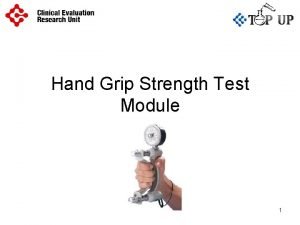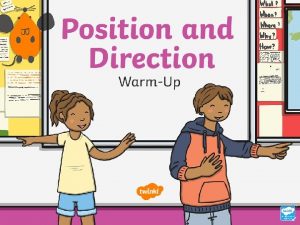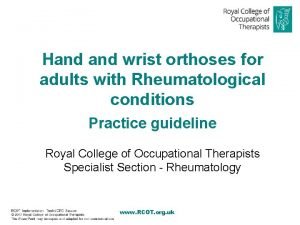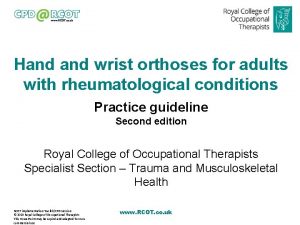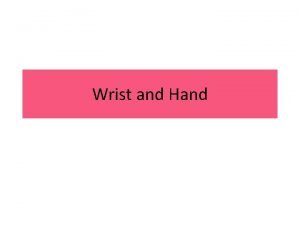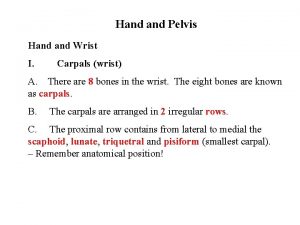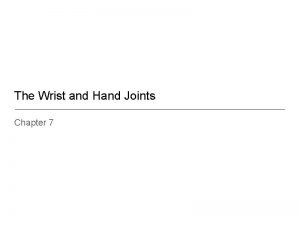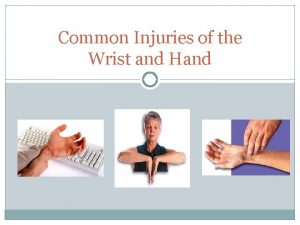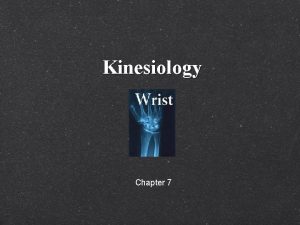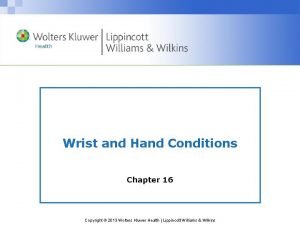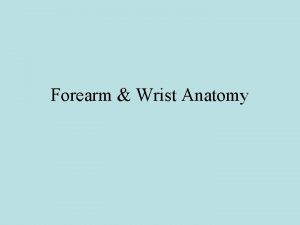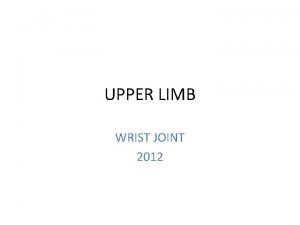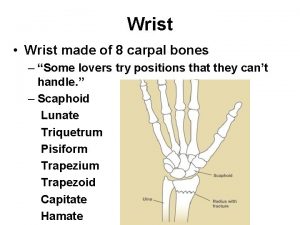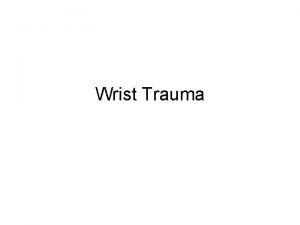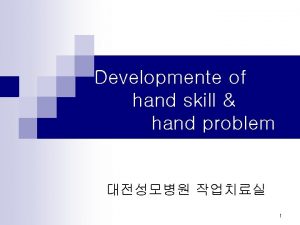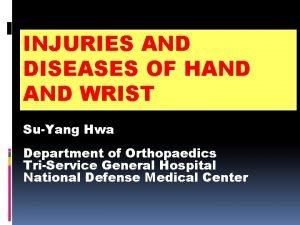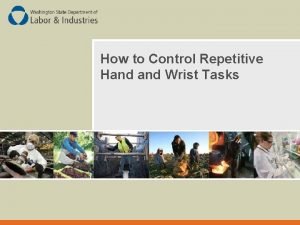Hand wrist orthoses for adults with rheumatological conditions

























- Slides: 25

Hand wrist orthoses for adults with rheumatological conditions Practice guideline Second edition Royal College of Occupational Therapists Specialist Section – Trauma and Musculoskeletal Health RCOT implementation Toolkit/CPD Session © 2020 Royal College of Occupational Therapists This Power. Point may be copied and adapted for noncommercial use www. RCOT. co. uk

Learning outcomes • To develop/enhance understanding of the importance of using practice guidelines to inform practice. • To explore the practice guideline recommendations in relation to current practice. • To develop/enhance understanding of how to use the RCOT Audit Form for use with the evidence-based recommendations. RCOT implementation Toolkit/CPD Session © 2020 Royal College of Occupational Therapists This Power. Point may be copied and adapted for noncommercial use www. RCOT. co. uk 2

Practice questions: • Is there evidence to support the use of hand wrist orthoses as an intervention for adults living with rheumatological conditions? • Is there any evidence of harm arising from the use of an orthosis that practitioners should be aware of? RCOT implementation Toolkit/CPD Session © 2020 Royal College of Occupational Therapists This Power. Point may be copied and adapted for noncommercial use www. RCOT. co. uk 3

Key objective of guideline To provide evidence-based recommendations that inform the practice of occupational therapists working with adults over 16 years of age who have rheumatological conditions, and who may benefit from a custom-made or prefabricated hand or wrist orthosis. It addresses occupational therapy intervention at any point during a person’s journey along the rheumatology care pathway. RCOT implementation Toolkit/CPD Session © 2020 Royal College of Occupational Therapists This Power. Point may be copied and adapted for noncommercial use www. RCOT. co. uk 4

Recommendation areas 1. Rheumatoid arthritis: orthoses for activity and rest 2. Osteoarthritis: base of thumb orthoses 3. Optimising outcomes for people accessing services: measuring outcomes, orthosis design and wearing regimen, experiences of people accessing services RCOT implementation Toolkit/CPD Session © 2020 Royal College of Occupational Therapists This Power. Point may be copied and adapted for noncommercial use www. RCOT. co. uk 5

Evidence-based recommendations Recommendations are based on the evidence available within 44 critically appraised papers. Each recommendation is assigned: • A strength scoring 1 or 2 (Strong or Conditional); • A quality grading A, B, C or D (High, Moderate, Low or Very Low). RCOT implementation Toolkit/CPD Session © 2020 Royal College of Occupational Therapists This Power. Point may be copied and adapted for noncommercial use www. RCOT. co. uk 6

Rheumatoid arthritis: orthoses for activity and rest Evidence overview: Functional wrist orthoses The evidence is strong with respect to the reduction of pain, as particularly evidenced by the systematic review undertaken by Ramsey et al (2014). A decrease in pain was a consistent outcome across studies, as measured using visual analogue scales. The reduction of symptoms, such as pain, is also a key motivator for adherence to wearing an orthosis. Risks associated with wearing a functional wrist orthosis were not specifically reported in the studies, but a potential negative impact on dexterity was highlighted. (RCOT 2020, p 24) RCOT implementation Toolkit/CPD Session © 2020 Royal College of Occupational Therapists This Power. Point may be copied and adapted for noncommercial use www. RCOT. co. uk 7

Rheumatoid arthritis cont’d Resting / night orthoses The effectiveness of a resting or night-positioning orthosis is not definitive. A positive impact on hand pain, grip and pinch strength, upper limb function and functional status was reported for participants with a mean of 9– 10 years’ disease duration, although the benefits beyond three months were not researched. Participants with early rheumatoid arthritis did not, however, obtain the same improvement in outcomes as determined by objective measures, although where the orthosis was used there was perceived effectiveness by participants. The evidence reviewed does not enable a specific recommendation to be made with respect to the prescription of a resting or night-positioning orthosis for service users with rheumatoid arthritis. (RCOT 2020, p 25) RCOT implementation Toolkit/CPD Session © 2020 Royal College of Occupational Therapists This Power. Point may be copied and adapted for noncommercial use www. RCOT. co. uk 8

Rheumatoid arthritis cont’d Orthoses for swan neck deformity Some evidence exists to support prescription of an orthosis to improve dexterity where correctable swan neck deformity exists for people with rheumatoid arthritis. Impact on other dimensions, such as dexterity-related pain and function, is weaker. Inherent with the use of silver ring splints or Oval-8® ring orthoses is the potential for some adverse side effects, and the range of both positive and negative factors influencing choice should be considered as part of the orthotic prescription process. The recipients of an orthosis for swan neck deformity need to be carefully selected, as factors such as long-standing deformity may mean an orthosis is not tolerated. (RCOT 2020, p 27) RCOT implementation Toolkit/CPD Session © 2020 Royal College of Occupational Therapists This Power. Point may be copied and adapted for noncommercial use www. RCOT. co. uk 9

Rheumatoid arthritis: orthoses for activity and rest Functional wrist orthoses 1. It is recommended that a functional wrist orthosis should be prescribed for people experiencing wrist pain as a result of rheumatoid arthritis. 1 A (Ramsey et al 2014 [A]; Thiele et al 2009 [C]; Veehof et al 2008 a [B]; Pagnotta et al 2005 [C]; Haskett et al 2004 [B]) Resting/night orthoses 2. It is suggested that where a night or resting orthosis is being considered as 2 B potentially beneficial to reduce symptoms for a person with rheumatoid arthritis, both subjective and objective measures are used for the monitoring and review of effectiveness. (Adams et al 2008 [B]; Silva et al 2008 [A]) Orthoses for swan neck deformity 3. It is suggested, when considering an orthosis for swan neck deformity, that a potential positive effect on dexterity should be balanced by possible adverse effects such as pressure and paraesthesia. 2 C (Giesen et al 2009 [C]; Giesen et al 2010 [D]; Spicka et al 2009 [D]; Ziljstra et al 2004 [C]) RCOT implementation Toolkit/CPD Session © 2020 Royal College of Occupational Therapists This Power. Point may be copied and adapted for noncommercial use www. RCOT. co. uk 10

Osteoarthritis: base of thumb orthoses Evidence overview: The evidence that orthoses have an impact on pain has been consistent in terms of direction of the outcomes, with an improvement being reported in 17 of the 19 studies described (9 of those being statistically significant). One study identified no change in pain. The impact of an orthosis on function was considered in 13 studies, 6 (46%) of which were statistically significant in favour of an improvement in function, with one identifying no change. Risks or adverse outcomes associated with these orthoses were rarely referred to in the studies. Changes in grip and pinch strength outcomes have been less consistent, with two studies identifying a decrease in grip, and statistical significance being rare for both measures. (RCOT 2020, p 33) RCOT implementation Toolkit/CPD Session © 2020 Royal College of Occupational Therapists This Power. Point may be copied and adapted for noncommercial use www. RCOT. co. uk 11

Osteoarthritis: base of thumb orthoses Orthoses to reduce pain and/or improve function 4. It is recommended that an orthosis should be prescribed for people experiencing pain and/or functional difficulties with activities of daily living as a result of thumb base osteoarthritis. 1 A (Cantero-Téllez et al 2018 [B]; Vegt et al 2017 [B]; Bani et al 2014 [C]; Hamann et al 2014 [D]; Hermann et al 2014 [B]; Maddali-Bongi et al 2014 [C]; Bani et al 2013 a [C]; Bani et al 2013 b [A]; Becker et al 2013 [B]; Kjeken et al 2011 a [A]; Kjeken et al 2011 b [A]; Sillem et al 2011 [B]; Gomes Carreira et al 2010 [B]; Boustedt et al 2009 [C]; Moe et al 2009 [A]; Rannou et al 2009 [A]; Egan and Brousseau 2007 [B]; Wajon and Ada 2005 [A]; Weiss et al 2004 [C]) [New evidence 2020] Orthoses to improve grip and pinch strength 5. It is suggested that an orthosis can improve the grip/pinch strength for some people with thumb base osteoarthritis. 2 C (Bani et al 2014 [C]; Hermann et al 2014 [B]; Maddali-Bongi et al 2014 [C]; Bani et al 2013 a [C]; Bani et al 2013 b [A]; Becker et al 2013 [B]; Sillem et al 2011 [B]; Wajon and Ada 2005 [A]; Weiss et al 2004 [C]) RCOT implementation Toolkit/CPD Session © 2020 Royal College of Occupational Therapists This Power. Point may be copied and adapted for noncommercial use www. RCOT. co. uk 12

Optimising outcomes for people accessing services Evidence overview: Measuring outcomes The evidence across the studies indicated that pain and function outcomes can be determined using self-reported measures such as the VAS or NRS for pain, and the DASH or AUSCAN for function. Measures can also be used to objectively determine performance for dexterity, grip and pinch strength. The combination of subjective (self-reported) and objective performance measures can provide reliable, valid and responsive information about the outcomes of orthotic intervention, and contribute to evidence of effectiveness. This would greatly increase the comparability within systematic reviews of the evidence around orthoses. (RCOT 2020, p 36) RCOT implementation Toolkit/CPD Session © 2020 Royal College of Occupational Therapists This Power. Point may be copied and adapted for noncommercial use www. RCOT. co. uk 13

Optimising outcomes for people accessing services cont’d Evidence overview: Orthosis design and wearing regimen A wide range of prefabricated orthoses are available commercially; others are custom-made. These may be fabricated from a variety of materials, including thermoplastics, neoprene leather and hybrid combinations. Research studies have compared a number of these orthoses, for both osteoarthritis and rheumatoid arthritis. While some orthoses showed a greater effect on pain reduction, and others were preferred by participants, there is no consistent evidence of a superior orthosis design. Furthermore, the variance of wearing regimen is particularly evident within the evidence. (RCOT 2020, p 38) RCOT implementation Toolkit/CPD Session © 2020 Royal College of Occupational Therapists This Power. Point may be copied and adapted for noncommercial use www. RCOT. co. uk 14

Optimising outcomes for people accessing services cont’d Evidence overview: Experiences of those who access services Research that involves the perspectives of people who access services can provide a richness which, when taken into account, can have the potential to enhance wearing of an orthosis in practice and, as such, can improve the outcomes sought by the individual. Views expressed included the importance of the support provided by the orthosis, its comfort and appearance, and ease of use, with ‘perceived need’ being a key driver for adherence of wearing. The range of potential issues influencing wearing of an orthosis implies that follow-up review of an orthosis is necessary to enable these to be addressed. Orthoses that are worn regularly are more likely to result in effective outcomes for those who wear them and, by association, more efficient use of occupational therapy service resources. (RCOT 2020, p 41) RCOT implementation Toolkit/CPD Session © 2020 Royal College of Occupational Therapists This Power. Point may be copied and adapted for noncommercial use www. RCOT. co. uk 15

Optimising outcomes for people accessing services Measuring outcomes 6. It is recommended that validated, standardised assessment and outcome measures are used pre- and post-provision of an orthosis to monitor progress and evaluate effectiveness. Measures may include assessing functional outcomes, understanding individual satisfaction and utilising Patient Reported Experience Measures (PREMs). 1 A (Duong et al 2018 [D]; Healy et al 2018 [B]; Aebischer et al 2016 [B]; Hammond et al 2016 [C]; Bertozzi et al 2015 [B]; Bani et al 2014 [C]; Hermann et al 2014 [B]; Maddali-Bongi et al 2014 [C]; Nasir et al 2014 [C]; Bani et al 2013 a [C]; Bani et al 2013 b [A]; Kjeken et al 2011 a [A]; Sillem et al 2011 [B]; Gomes Carreira et al 2010 [B]; Boustedt et al 2009 [C]; Giesen et al 2009 [C]; Rannou et al 2009 [A]; Boer et al 2008 [C]; Silva et al 2008 [A]; Veehof et al 2008 a [B]; Pagnotta et al 2005 [C]; Wajon and Ada 2005 [A]; Haskett et al 2004 [B]; Weiss et al 2004 [C]; Zijlstra et al 2004 [C]) [Statement amended and new evidence 2020] Orthosis design and wearing regimen 7. It is suggested that given the inconsistent evidence of a superior orthosis fabrication/design, or wearing regimen, the orthosis selected should maximise occupational performance and individual choice. (Cantero-Téllez et al 2018 [B]; Almeida et al 2017 [B]; Vegt et al 2017 [B]; Bertozzi et al 2015 [B]; Spaans et al 2015 [B]; Nasir et al 2014 [C]; Bani et al 2013 b [A]; Becker et al 2013 [B]; Sillem et al 2011 [B]; Giesen et al 2009 [C]; Thiele et al 2009 [C]; Wajon and Ada 2005 [A]; Haskett et al 2004 [B]; Weiss et al 2004 [C]) [New evidence 2020] RCOT implementation Toolkit/CPD Session © 2020 Royal College of Occupational Therapists This Power. Point may be copied and adapted for noncommercial use www. RCOT. co. uk 2 A 16

Optimising outcomes for people accessing services Service user experiences 8. It is recommended that to optimise adherence to wearing a 1 A prescribed orthosis, the occupational therapist should discuss with the service user potential benefits and limitations; practicalities of use and comfort; provide the opportunity to try on orthoses prior to issue; and routinely arrange follow-up review of the intervention. (De Boer et al 2008 [C]; Gooberman-Hill et al 2013 [D]; Mc. Kee and Rivard 2004 [D]; Veehof et al 2008 b [C]) RCOT implementation Toolkit/CPD Session © 2020 Royal College of Occupational Therapists This Power. Point may be copied and adapted for noncommercial use www. RCOT. co. uk 17

Impact of practice guideline for you: the practitioner • Challenges / affirms your current practice. • Provides evidence-based recommendations to inform and support your practice. • Raises awareness of benefits and risks, and organisational and financial barriers. • Provides a vehicle for you to audit and justify your practice. • Assists in communicating your role to members of the multidisciplinary team. RCOT implementation Toolkit/CPD Session © 2020 Royal College of Occupational Therapists This Power. Point may be copied and adapted for noncommercial use www. RCOT. co. uk 18

Impact of practice guideline for managers • Provides evidence of the need for occupational therapy input into services for adults with rheumatological conditions. • Provides a structure to audit the work of occupational therapists within the service to improve service quality. • Provides a vehicle for justifying service provision. RCOT implementation Toolkit/CPD Session © 2020 Royal College of Occupational Therapists This Power. Point may be copied and adapted for noncommercial use www. RCOT. co. uk 19

Impact of practice guideline for commissioners • Articulates the need for occupational therapy interventions within services for adults with rheumatological conditions. • Provides recommendations developed by a NICEaccredited process. • Can help educate commissioners to identify learning needs for the workforce. • Audit form provides a mechanism to review service delivery in accordance with the evidence. RCOT implementation Toolkit/CPD Session © 2020 Royal College of Occupational Therapists This Power. Point may be copied and adapted for noncommercial use www. RCOT. co. uk 20

Impact of practice guideline for people who access services • The recommendations reinforce the fundamental importance of the perspective of people who access services. • In being adopted by services and occupational therapists, the guideline should improve the consistency and quality of intervention for people who access services. • Gives assurance that practitioners use the available evidence to support interventions. RCOT implementation Toolkit/CPD Session © 2020 Royal College of Occupational Therapists This Power. Point may be copied and adapted for noncommercial use www. RCOT. co. uk 21

Perspectives from people who access services “Try to get therapist to underline that the outcome might not be clear if only restricted to a two- to four-week review…I know from personal experience that it has taken even four to six weeks to get the full benefit of the splints. ” “I found out there are not only beige wrist splints but black as well…if there is no extra cost incurred, could we have a little choice? ” “I suspect I am no different to many service users in wanting to know what are the potential benefits and potential risks of any intervention to me personally…strengthening or highlighting the perceived benefit of the recommendation to the user is fundamental in achieving compliance. ” “I am 79 – all my working life I was a draughtsman and the ‘splints’ did help reduce pain. ” 22

Case study example Insert local case study example here and support group discussion of the application of the guideline 23

Practice guideline resources • Royal College of Occupational Therapists (2020) Hand wrist orthoses for adults with rheumatological condition, 2 nd ed. London: RCOT. • Audit Form. • Quick Reference and Implementation Guide. Resources are available from the Royal College’s website at: https: //www. rcot. co. uk/practice-resources/rcot-practice -guidelines RCOT implementation Toolkit/CPD Session © 2020 Royal College of Occupational Therapists This Power. Point may be copied and adapted for noncommercial use www. RCOT. co. uk 24

Methodology 1. Guideline development group established 5. Critically appraise articles 4. Screen findings 6. Development of practice guideline recommendations 9. Published by RCOT 2015 3. Literature search 7. Peer review, stakeholder and service user consultation 8. Final draft approved by RCOT Publications Group 10. Review undertaken RCOT implementation Toolkit/CPD Session © 2020 Royal College of Occupational Therapists This Power. Point may be copied and adapted for noncommercial use 2. Guideline scope defined involving stakeholders 11. Second edition published by RCOT 2020. www. RCOT. co. uk 25
 Ankle foot orthoses
Ankle foot orthoses Anatomi wrist joint
Anatomi wrist joint Chapter 24 the forearm, wrist, hand, and, fingers
Chapter 24 the forearm, wrist, hand, and, fingers Chapter 20 the elbow wrist and hand
Chapter 20 the elbow wrist and hand Hand wrist injury westfield
Hand wrist injury westfield Anatomi wrist
Anatomi wrist Tools equipment and processes
Tools equipment and processes Ape hand vs hand of benediction
Ape hand vs hand of benediction Worker machine chart example
Worker machine chart example Handsoft pro
Handsoft pro Right hand in the air
Right hand in the air Wrist flexion and extension muscles
Wrist flexion and extension muscles Alabama drivers manual
Alabama drivers manual Wir sind durch not und freude gegangen hand in hand
Wir sind durch not und freude gegangen hand in hand Hour hand
Hour hand Father mother sister brother hand in hand with one another
Father mother sister brother hand in hand with one another Quarter time
Quarter time Ulnar surface of hand
Ulnar surface of hand How to read dynamometer
How to read dynamometer Right hand in the air left hand in the air
Right hand in the air left hand in the air Father mother sister brother hand in hand with one another
Father mother sister brother hand in hand with one another Hand by hand
Hand by hand Kung som dog 1611
Kung som dog 1611 Tack för att ni lyssnade
Tack för att ni lyssnade Att skriva debattartikel
Att skriva debattartikel Tobinskatten för och nackdelar
Tobinskatten för och nackdelar
